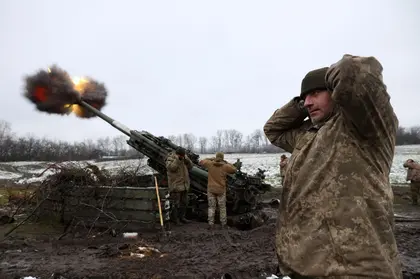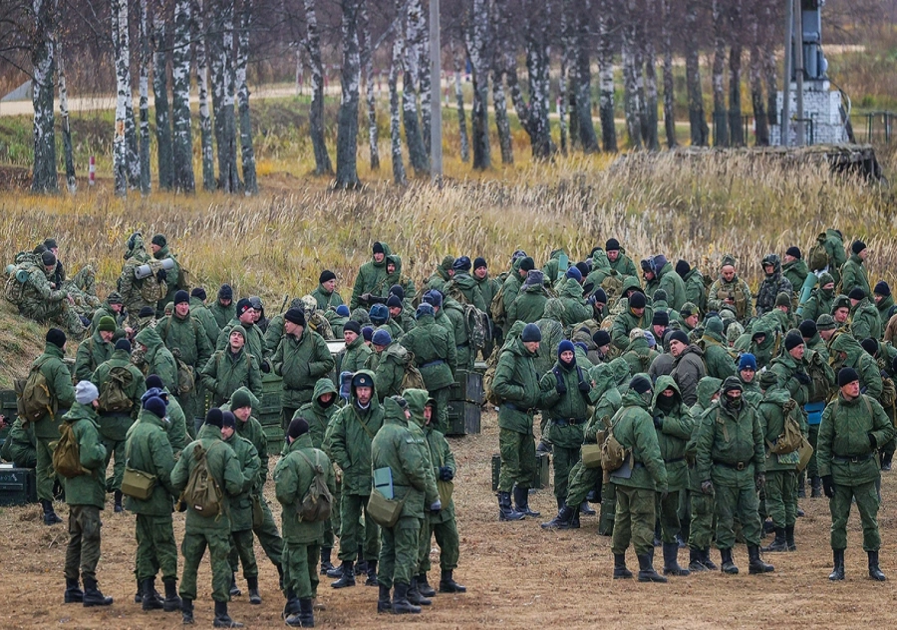Following an almost six-month hiatus, the US announced on April 24 that it would resume deliveries of military assistance to Ukraine, with a particular priority being air defense and 155mm artillery ammunition. On Monday May 6, President Volodymyr Zelensky confirmed the materiel was on its way but little had arrived.
Reports from the battlefield suggest that some munitions have begun to reach the front lines and that Kyiv’s long-running heavy ammunition shortage could be easing. On May 1 some Ukrainian milbloggers began to report that artillery units had received slight increases in artillery munitions while a week later others were still complaining of severe shortages.
JOIN US ON TELEGRAM!
Follow our coverage of the war on the @Kyivpost_official.
In contrast, a number of Russian bloggers were describing an apparent end to Ukraine’s ammunition deficit during the same period, claiming renewed artillery strikes against Russian military and civilian targets many using cluster munitions and remotely delivered landmines.
Russia’s claims
Readovka, a Russian social media platform with 2.6 million followers run by Aleksey Kostylev, said on Monday that Ukrainian forces were using rocket artillery, 155mm conventional high explosive rounds, and cluster munitions in continuing bombardments in the Donetsk sector.
Aleksandr Sladkov, a self-proclaimed “military correspondent” focusing on frontline developments, also reported on Monday that Ukrainian units had fired long-range artillery rockets against a civilian district in the city of Belgorod. Sladkov claimed that a rocket struck a house in the village of Nikolske killing a man and wounding a child, which he and local media said was a cluster munitions strike.

Zelensky Expects Russian Offensive in Northeast Ukraine to Intensify
Dva Mayora, another popular Russian milblogger said on Sunday that Ukrainian forces defending a bridgehead on the Dnipro River in the southern Kherson sector had deployed a new artillery-delivered mine designed to explode in the air over a target or, if it reaches the ground in intact, that will detonate if picked up.
He issued a warning to Russian troops saying: “Warrior! Watch your step! Don’t pick up things you don’t know! IT WILL KILL!... There’s no reason to pick up something that you didn’t put down, you don’t have to touch it! You should look very closely at all the [vulgar] that can be around your feet. If there is no grass, then no problem. If a shell hit recently, it’s easy to see where everything is burned, everything is in plain sight. But if these things have been lying around for a while and the grass is overgrown, that’s a problem.”
The blogger complained that Russian troops finding the mines are taking unnecessary risks and at times getting wounded and killed by trying to hunt down the mines and use their rifles to shoot them.
In Russian-occupied Donetsk, Moscow’s proxy Denis Pushilin claimed artillery-delivered PFM anti-personnel landmines (APL), sometimes called “butterfly” or “dragon’s tooth” because of their shape, had hospitalized a civilian man with serious injuries on May 8.

A public statement issued by the Donetsk occupation authorities on Sunday said a married couple in the Telmanovo area both lost “lower extremities” and were hospitalized in critical condition after detonating an unspecified type of artillery-delivered mine.
The pro-Russian Dokladyvaet Desantnik Telegram channel reported Ukrainian forces “on all sectors of the front” had returned to the use of cluster munitions and claimed that Russian troops in the Robotyne sector were under regular artillery fire over the weekend with remotely delivered mines hitting their positions and areas around them.
“For the most part the [vulgar word for Ukrainians] right now are mostly hitting us with artillery and cluster munitions along the entire line of contact, and they are actively mining forward positions and approaches to them,” according to an April 29 combat report.
Russian milblogger PizdSapper, a self-described Russian combat engineer and expert in NATO munitions claimed in an April 30 report that Ukraine had fired 155mm howitzer ammunition loaded with the M-70 mines mine. He described the hockey puck-shaped mines as an updated version of Cold War-era munition equipped with multiple detonators to increase casualties and prevent handling.
Another pro-Kremlin information platform VDV Z Chesnost I Spravedlivost said on May 5 that artillery delivered mines with a flat cylindrical shape had hit Russian positions around the village of Krynky, in the southern Kherson sector, where Ukrainian marines still hold a small bridgehead across the Dnipro River.
The report claimed that the mines not only blow up if touched, but contain a proximity fuse that will detonate the device if motion is detected nearby.
Fact check – PFM-1 APL
It was confirmed in July 2023 that the US had provided Kyiv with 155mm dual-purpose improved conventional munition (DPICM) cluster munitions, which have been extensively used against military targets including in the Donetsk and Kherson sectors.
There have been no previously verified reports of the use of PFM-1 anti-personnel landmines or other remotely delivered mines by Ukraine in these areas but there have been records of Russian forces deploying them on several occasions.
The PFM-1 mines were extensively used by Soviet forces in Afghanistan, many of which were still able to function 20 years or more after they were laid. It is likely that as occupied areas are liberated or others are taken by Russian forces these mines will remain a threat to civilians and military alike.
Fact Check – Ukrainian use of APL
Ukraine is a signatory of the 1997 Convention on the Prohibition of the Use, Stockpiling, Production and Transfer of Anti-Personnel Mines and on their Destruction, known informally as the Ottawa Treaty or the Anti-Personnel Mine Ban. Russia is not.
Ukraine undertook the destruction of the bulk of its conventional APL stockpile under a NATO sponsored Partnership for Peace (PfP) program between 2002-2003. Ukraine destroyed a third of its stocks of PFM-1 APL, some 2.5 million mines, under a joint NATO-European Union program between 2012-18. The program was curtailed due to lack of funding.

As a result of more than two years of intense conventional warfare on its territory, and intense use of mines and cluster munitions by both Russia and Ukraine in the war, Ukraine is now the most heavily-mined country on Earth, according to the Amnesty International 2023-24 annual report.
Fact Check – M-70
The mine shown on Russian social media is the US M70 High-Explosive Remote Anti-Armor Mine (HE-RAAM) which is part of the Family of Scatterable Mines (FASCAM) first introduced in the 1980s. They are deployed by base ejecting 155mm projectiles, each of which contains nine mines.

A total of 6,000 US 155 mm HE-RAAM rounds were contained in two US military assistance packages provided in September and October 2022.
The M-70 RAAM is exclusively an anti-vehicle / anti-armor munition. It uses an electronic Magnetic (MAG) influence fuse which is armed a short delay after deployment. It is only initiated when a vehicle containing sufficient metal comes within range, when its shaped-charge warhead detonates and propels a metal plate at the target.
The mine is designed to self-destruct after a specific time. While it may be a hazard to military personnel, it does so to avoid remaining in a dangerous state for any length of time, particularly after hostilities cease.
It does not contain a multi-fusing or motion detection system but some may include anti-handling devices to prevent them from being moved by the enemy or it might be that coincidentally Russian troops have approached the mine as the self-destruct element initiated. As with any landmine they should never be handled but moved and/or destroyed remotely – as any properly trained soldier knows.
You can also highlight the text and press Ctrl + Enter







Comments ( 1)
A fact checking article which starts off by stating the US had a 6 month hiatus in sending military aide, when there is very open information regarding military aide in December and earlier in the year. I understand what you were going at but if you want to be trusted in these you need be more CLEAR otherwise it will be used to dismiss the whole article as nonsense by some.